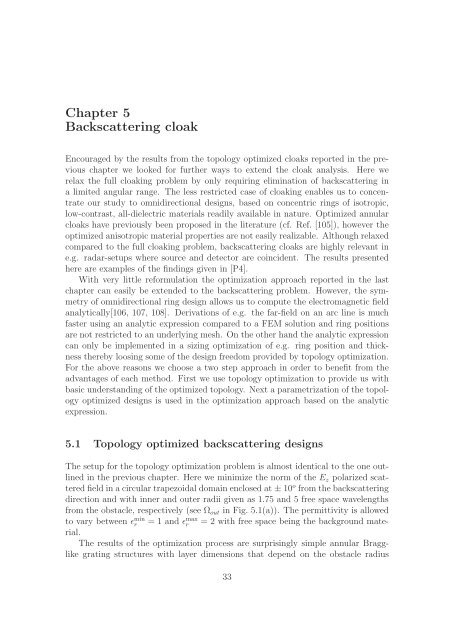Wave Manipulation by Topology Optimization - Solid Mechanics
Wave Manipulation by Topology Optimization - Solid Mechanics
Wave Manipulation by Topology Optimization - Solid Mechanics
You also want an ePaper? Increase the reach of your titles
YUMPU automatically turns print PDFs into web optimized ePapers that Google loves.
Chapter 5<br />
Backscattering cloak<br />
Encouraged <strong>by</strong> the results from the topology optimized cloaks reported in the previous<br />
chapter we looked for further ways to extend the cloak analysis. Here we<br />
relax the full cloaking problem <strong>by</strong> only requiring elimination of backscattering in<br />
a limited angular range. The less restricted case of cloaking enables us to concentrate<br />
our study to omnidirectional designs, based on concentric rings of isotropic,<br />
low-contrast, all-dielectric materials readily available in nature. Optimized annular<br />
cloaks have previously been proposed in the literature (cf. Ref. [105]), however the<br />
optimized anisotropic material properties are not easily realizable. Although relaxed<br />
compared to the full cloaking problem, backscattering cloaks are highly relevant in<br />
e.g. radar-setups where source and detector are coincident. The results presented<br />
here are examples of the findings given in [P4].<br />
With very little reformulation the optimization approach reported in the last<br />
chapter can easily be extended to the backscattering problem. However, the symmetry<br />
of omnidirectional ring design allows us to compute the electromagnetic field<br />
analytically[106, 107, 108]. Derivations of e.g. the far-field on an arc line is much<br />
faster using an analytic expression compared to a FEM solution and ring positions<br />
are not restricted to an underlying mesh. On the other hand the analytic expression<br />
can only be implemented in a sizing optimization of e.g. ring position and thickness<br />
there<strong>by</strong> loosing some of the design freedom provided <strong>by</strong> topology optimization.<br />
For the above reasons we choose a two step approach in order to benefit from the<br />
advantages of each method. First we use topology optimization to provide us with<br />
basic understanding of the optimized topology. Next a parametrization of the topology<br />
optimized designs is used in the optimization approach based on the analytic<br />
expression.<br />
5.1 <strong>Topology</strong> optimized backscattering designs<br />
The setup for the topology optimization problem is almost identical to the one outlined<br />
in the previous chapter. Here we minimize the norm of the Ez polarized scattered<br />
field in a circular trapezoidal domain enclosed at ± 10 o from the backscattering<br />
direction and with inner and outer radii given as 1.75 and 5 free space wavelengths<br />
from the obstacle, respectively (see Ωout in Fig. 5.1(a)). The permittivity is allowed<br />
to vary between ɛmin r =1andɛmax r = 2 with free space being the background material.<br />
The results of the optimization process are surprisingly simple annular Bragglike<br />
grating structures with layer dimensions that depend on the obstacle radius<br />
33

















